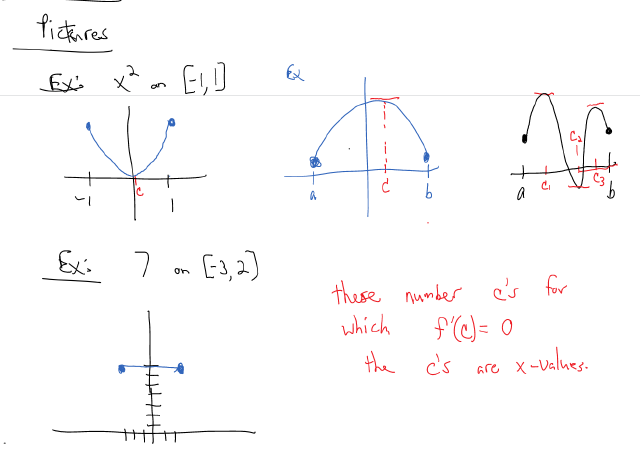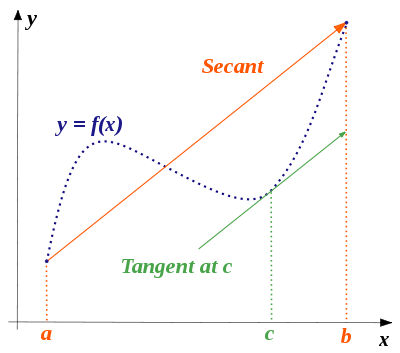Section 3.2, The Mean Value Theorem
In this section we’re going to explore the concept of a location where a function attains the average or or mean value.
It’s not mean 😡 , but mean 🧮.
We’ll start with Rolle’s theorem that tells us if something went up and came back down, there had to be a time when its derivative is 0.
Rolle’s Theorem
Let $f$ be a function. If the following properties are true:
- $f$ is continuous on the interval $[a, b]$
- $f$ is differentiable on the interval $(a, b)$, and
- $f(a) = f(b)$
then there is a number $c$ in the interval $(a,b)$ so that $f’(c) = 0$.
Some pictures:
Here are some (ugly, hand-drawn) graphs showing examples

Example
Verify the hypotheses of Rolle’s Theorem and find all values $c$ from the conclusion for the function on the given interval: $$ f(x) = 5-12x + 3x^2 \text{ on } [1, 3] $$
The Mean Value Theorem
The basic idea is if you have a differentiable function on an interval, there is some point whose tangent line has the same slope (is parallel) as the secant line between endpoints. Here’s a picture from
wikipedia:

Formal statement of the Mean Value Theorem
Let $f$ be a function. If the following properties are true:
- $f$ is continuous on the interval $[a, b]$
- $f$ is differentiable on the interval $(a, b)$, and
then there is a number $c$ in the interval $(a,b)$ so that 1 $$ f’(c) = \dfrac{f(b)-f(a)}{b - a} $$
or, equivalently, $$ f(b) - f(a) = f’(c)(b-a) $$
By the way, if this looks like the slope formula or the point-slope form of a line, good! It’s all related!
Note: The Mean Value Theorem tells us that there is a number $c$ in the interval, but it doesn’t tell us what it is. For that, we will need algebra.
Example
Determine all numbers $c$ that satisfy the conclusions of the Mean Value Theorem for the following function $$ f\left( x \right) = {x^3} + 2{x^2} - x\hspace{0.25in}{\rm{on}}\hspace{0.25in}\left[ { - 1,2} \right] $$
Example
Suppose that we know that $f(x)$ is continuous and differentiable on the interval $[3, 10]$, and let’s also suppose that we know that $f(3) = -2$ and the $f’(x) \le 8$. What is the largest possible value of $f(10)$?
An Example
You enter the I35 turnpike at 4:15pm at mile marker 57 (the 21st street entrance) You take exit 127 for Emporia at 5:00pm. No highway patrol officers caught you speeding. But was there a time when you should have been pulled over?
{{ < spoiler > }}
The Mean Value Theorem says that if $f$ is a continuous function on the closed interval and differentiable on the open interval $(a, b)$, then there is some $c$ in $(a, b)$ such that $$ f’(c) = \dfrac{f(b)-f(a)}{b - a} $$ Interpreting $f(t)$ to be the distance in miles traveled down the turnpike after $t$ time hours, then we can plug in $t = 0$ for 4:15pm and $t=3/4$ for 5:00pm (since we can think of going from from 0 hours to 3/4 of an hour for our journey). Then $f(0) = 0$ (we haven’t traveled yet), and $f(3/4) = 127 - 57 = 70$
The MVT tells us there is some value $c$ between 0 and 3/4 hour such such: $$ f’(c) = \dfrac{f(3/4) - f(0)}{3/4 - 0} = \dfrac{70 - 0}{3/4 - 0} \approx 93.33 \text{mph} $$
So although your didn’t get caught (maybe, say, Waze told you about a speed trap), your average speed was over 90mph, and there was some time between 4:15 and 5:00 when you were doing it, you little lawbreaker, you! 😈
{{ </ spoiler > }}
A real world example(?)
Here’s a photo of a bridge in Beijing celebrating the MVT
Two more related results
Theorem If $f’(x) = 0$ for all $x$ on an interval $(a,b)$, then $f$ is constant on $(a, b)$
Theorem If $f’(x) = g’(x)$ for all $x$ in the interval $(a,b)$, then $f - g$ is constant on $(a, b)$. That is $$ f(x) = g(x) +c \text{ where } c \text{ is some constant.} $$
Example
Let $f(x) = x^2$ and $g(x) = x^2 + 42$. Notice that
$f’(x) = 2x$ and $g’(x) = 2x$ for any $x$ on all $(-\infty, \infty)$. Then we know the functions $f$ and $g$ must differ by a constant; that constant is $42$.
I’m going to, in my own colloquial way, call these functions “cousins”. They share the same derivative, so they’re in the same family of functions3. This is an important thing we’ll discuss more when we get to integral calculus!
Note if $f(b) = f(a)$, this is just Rolle’s Theorem again. ↩︎
https://commons.wikimedia.org/wiki/File:Beijing-Mean-Value-Theorem-3733.jpg ↩︎
Actual mathematicians, such as our textbook author call them a ‘family’. I’m a goof and call them cousins. ↩︎
